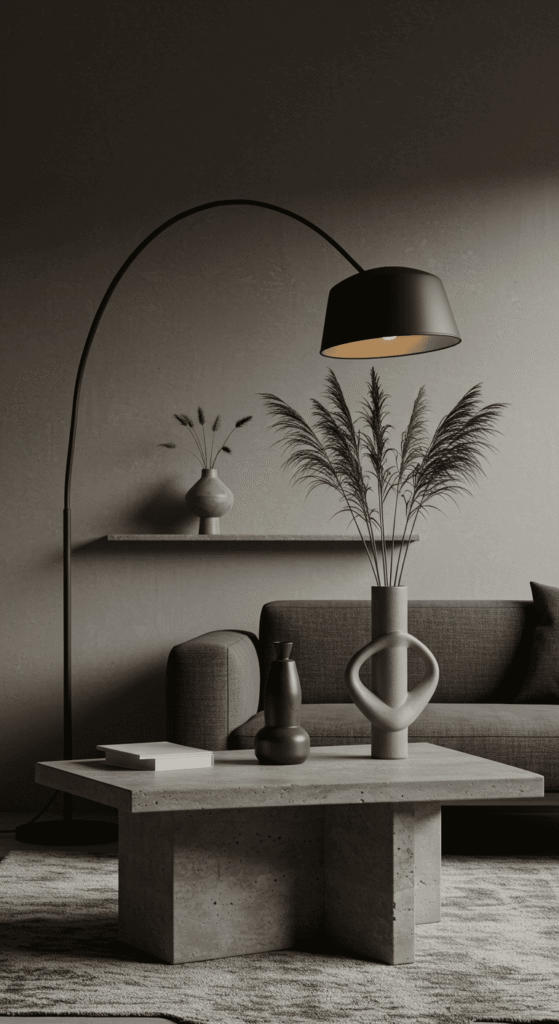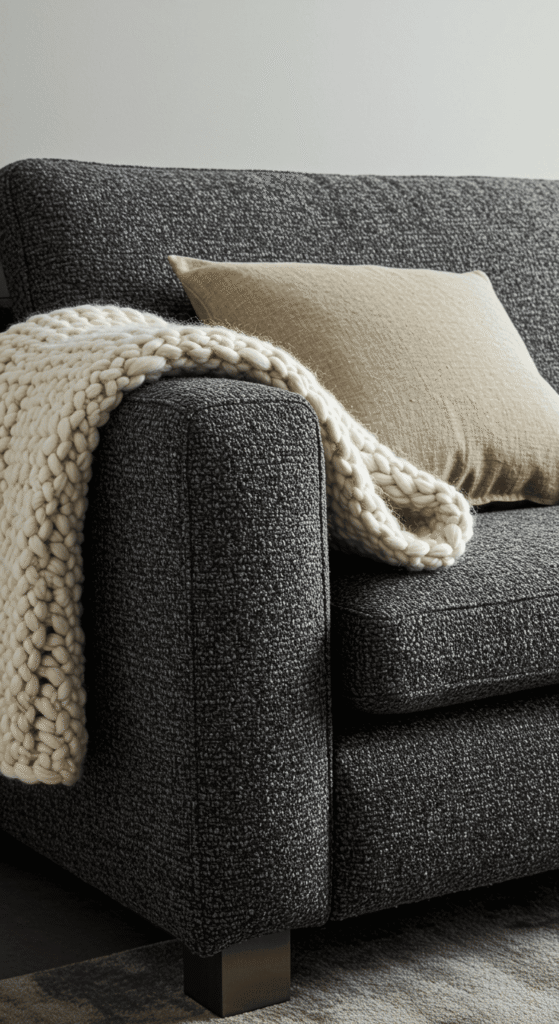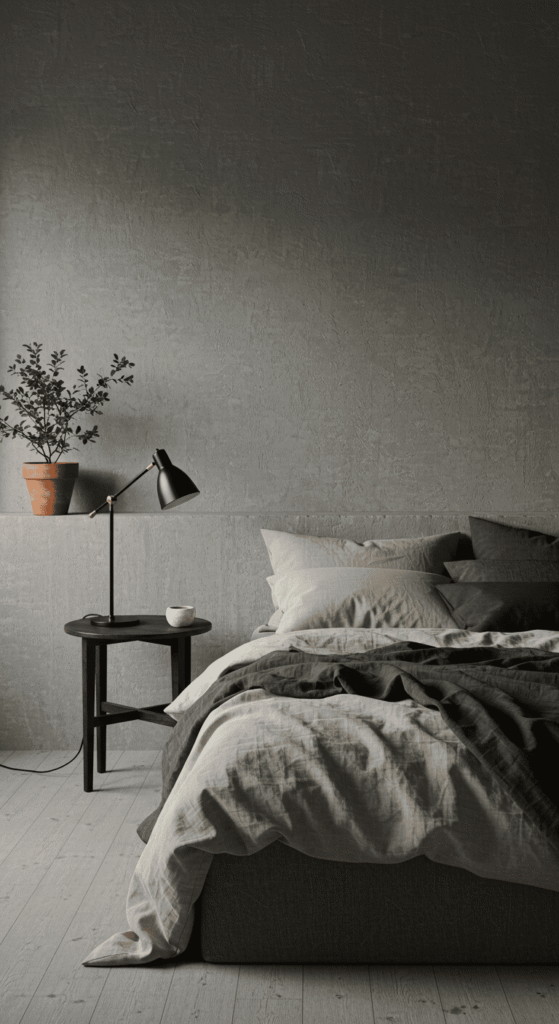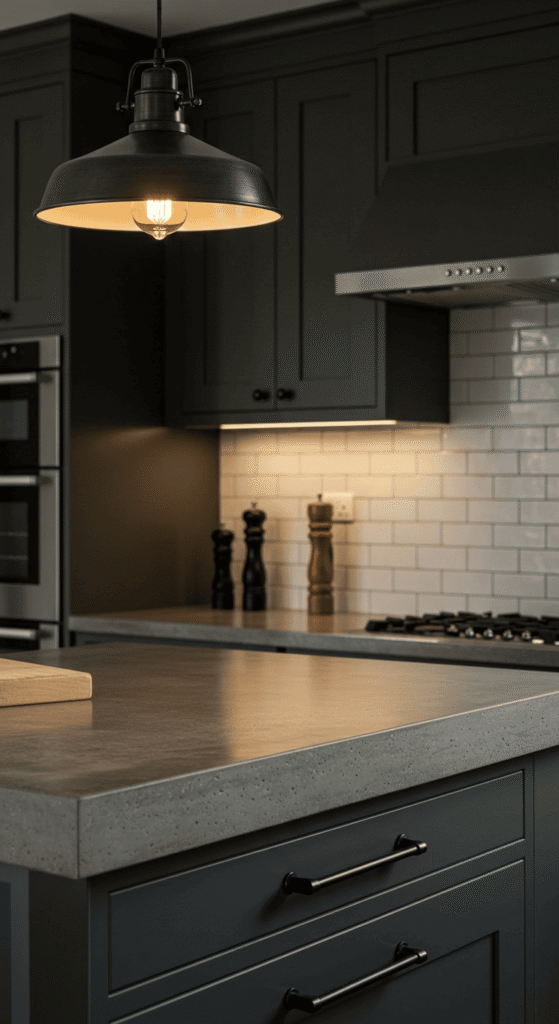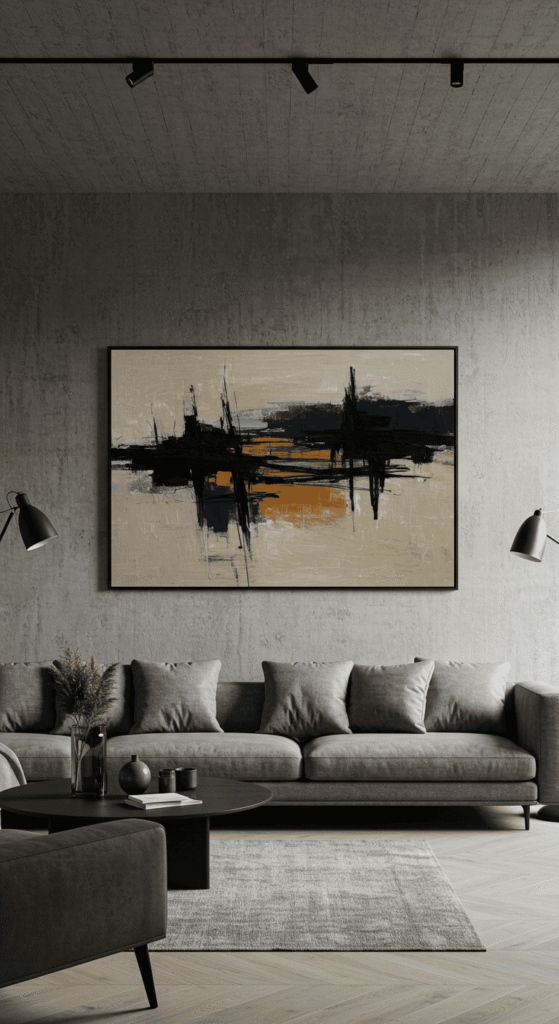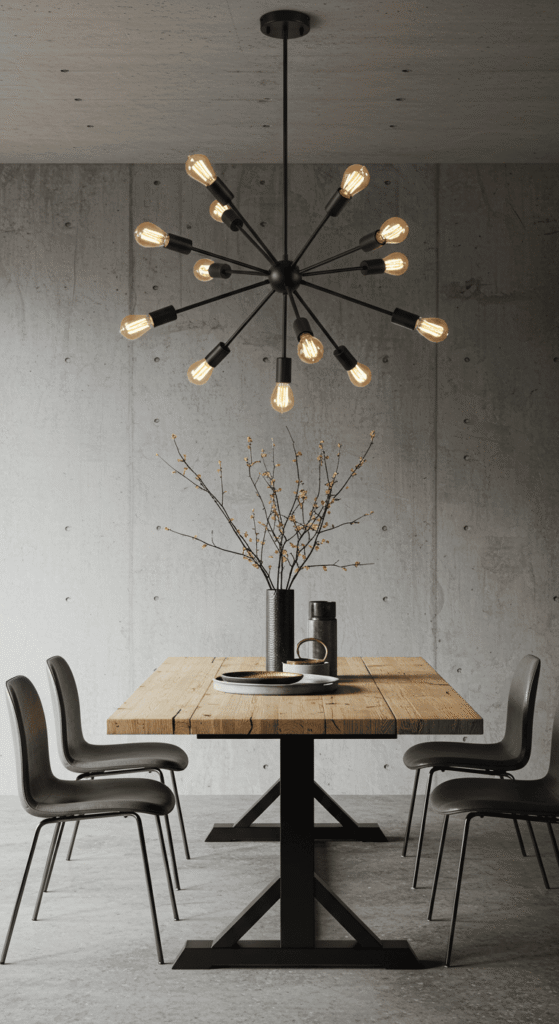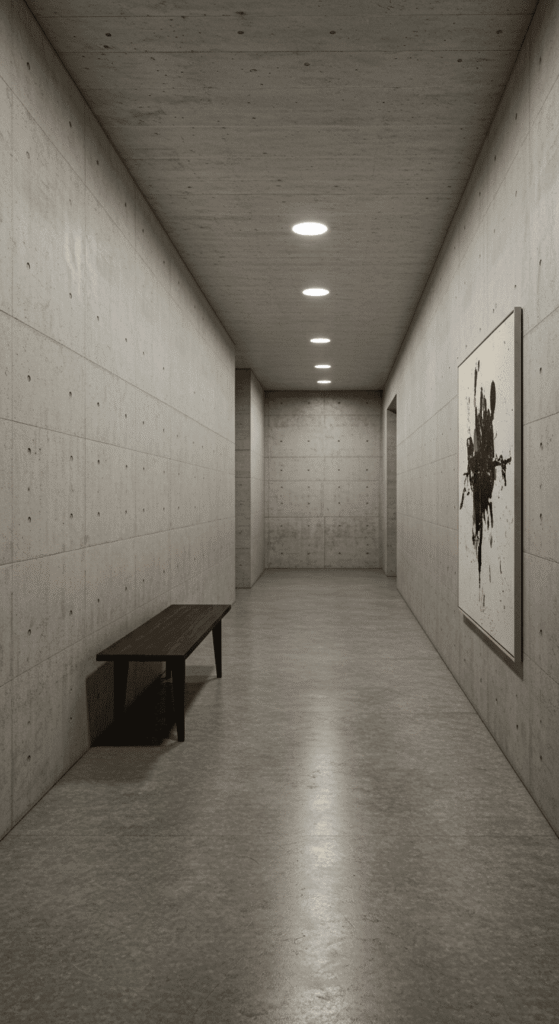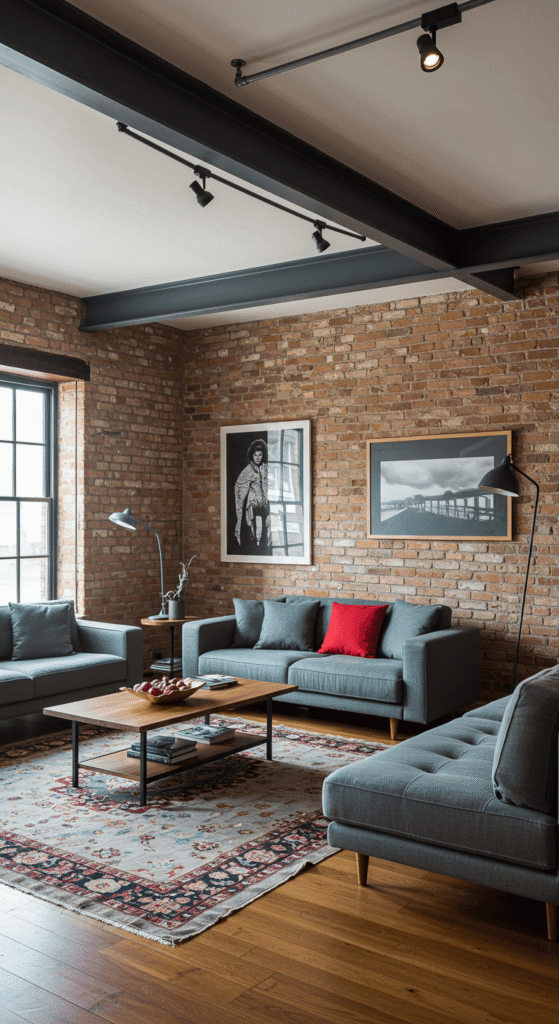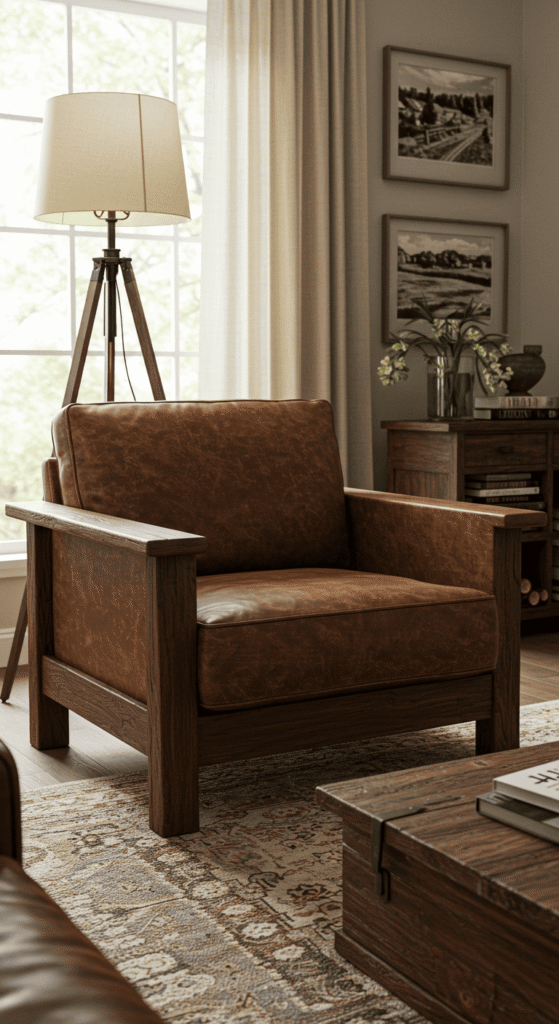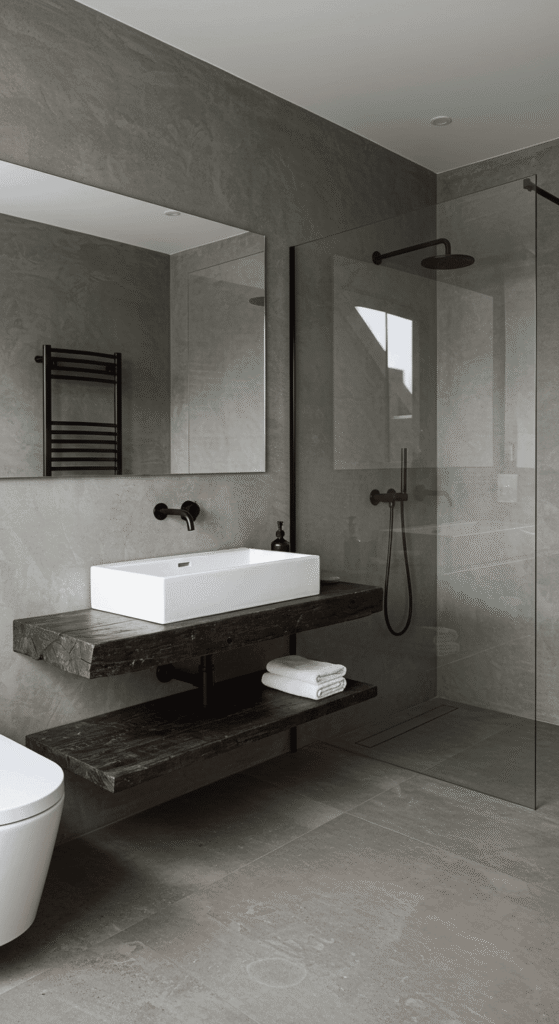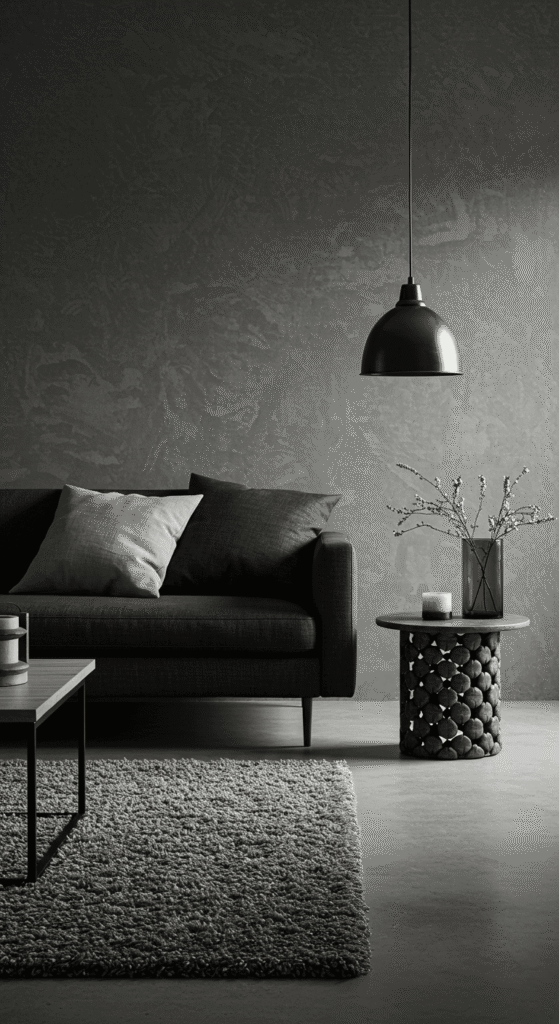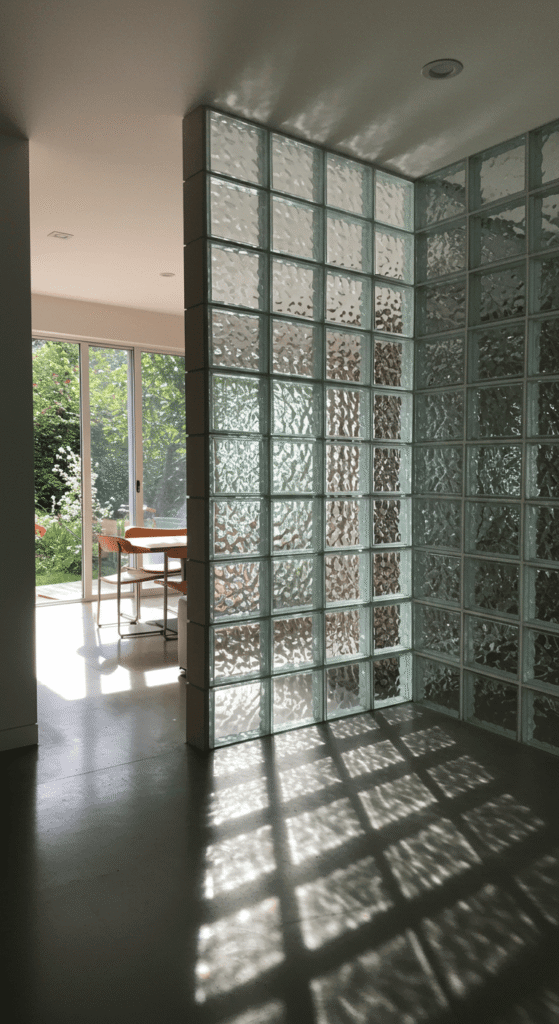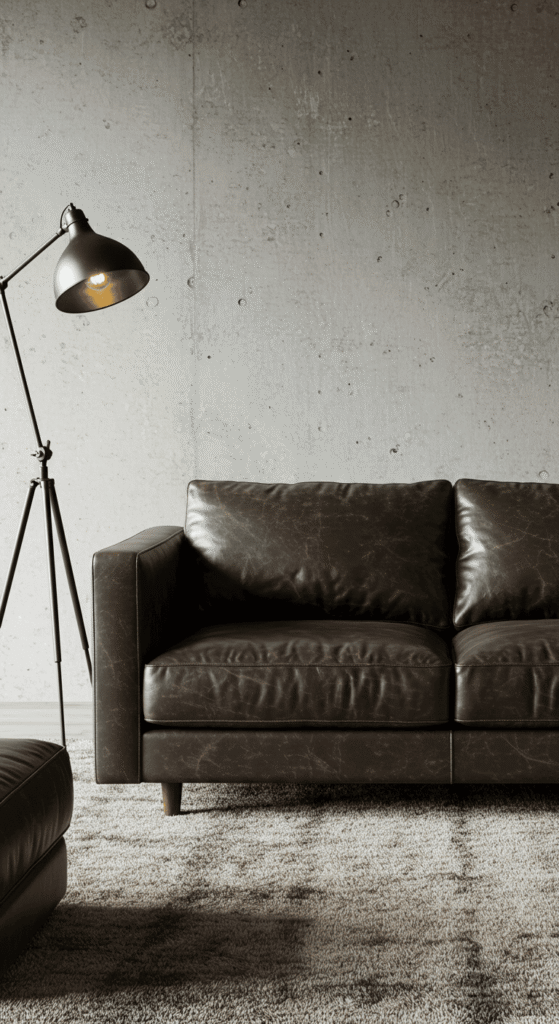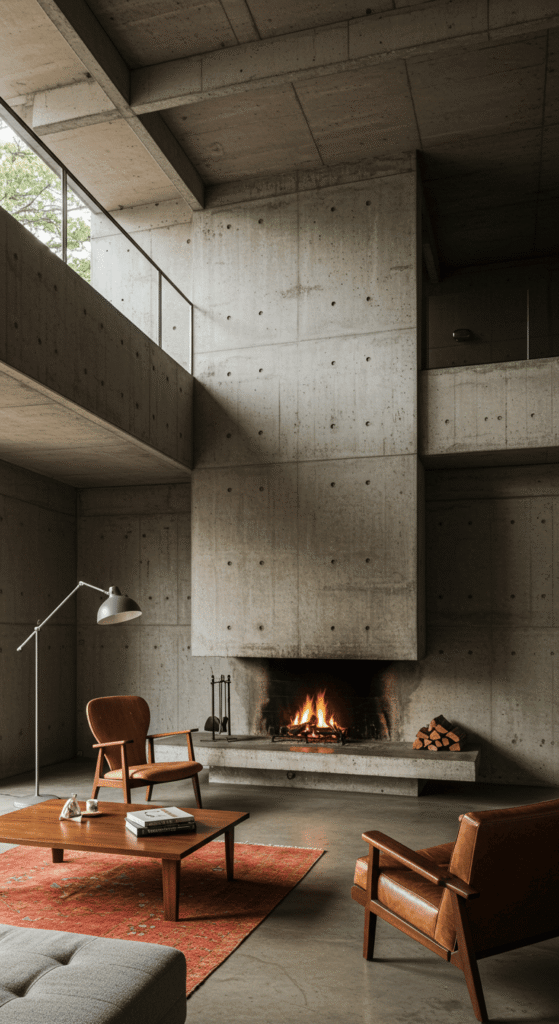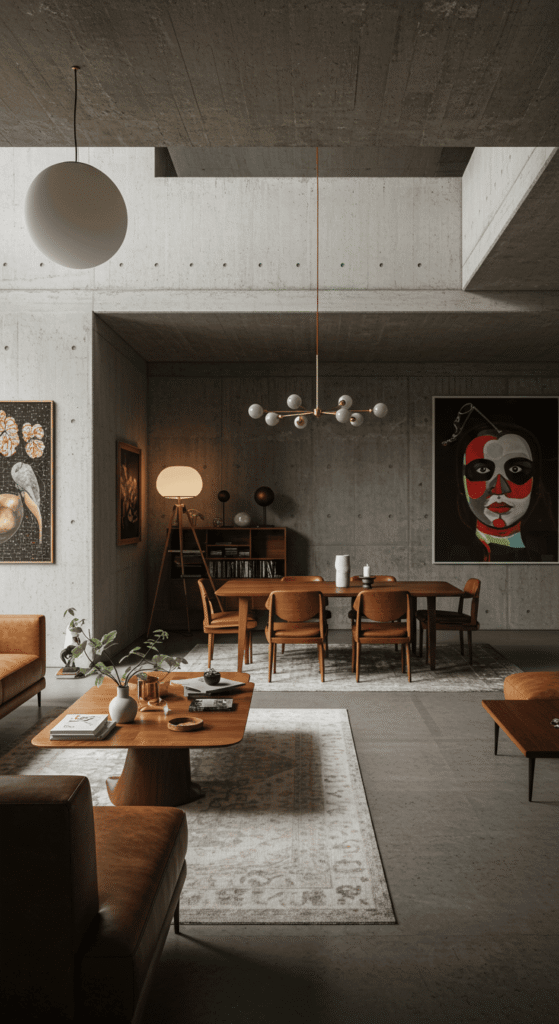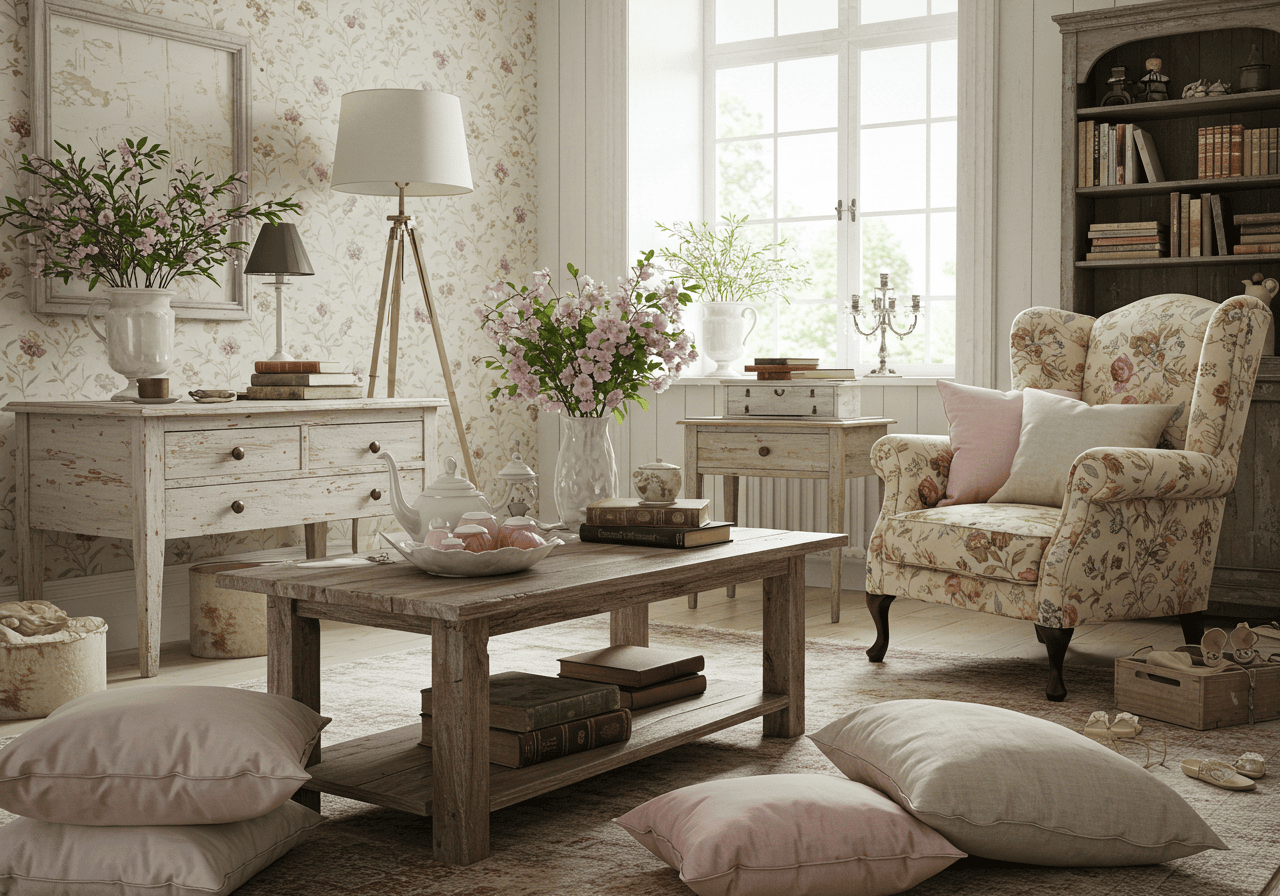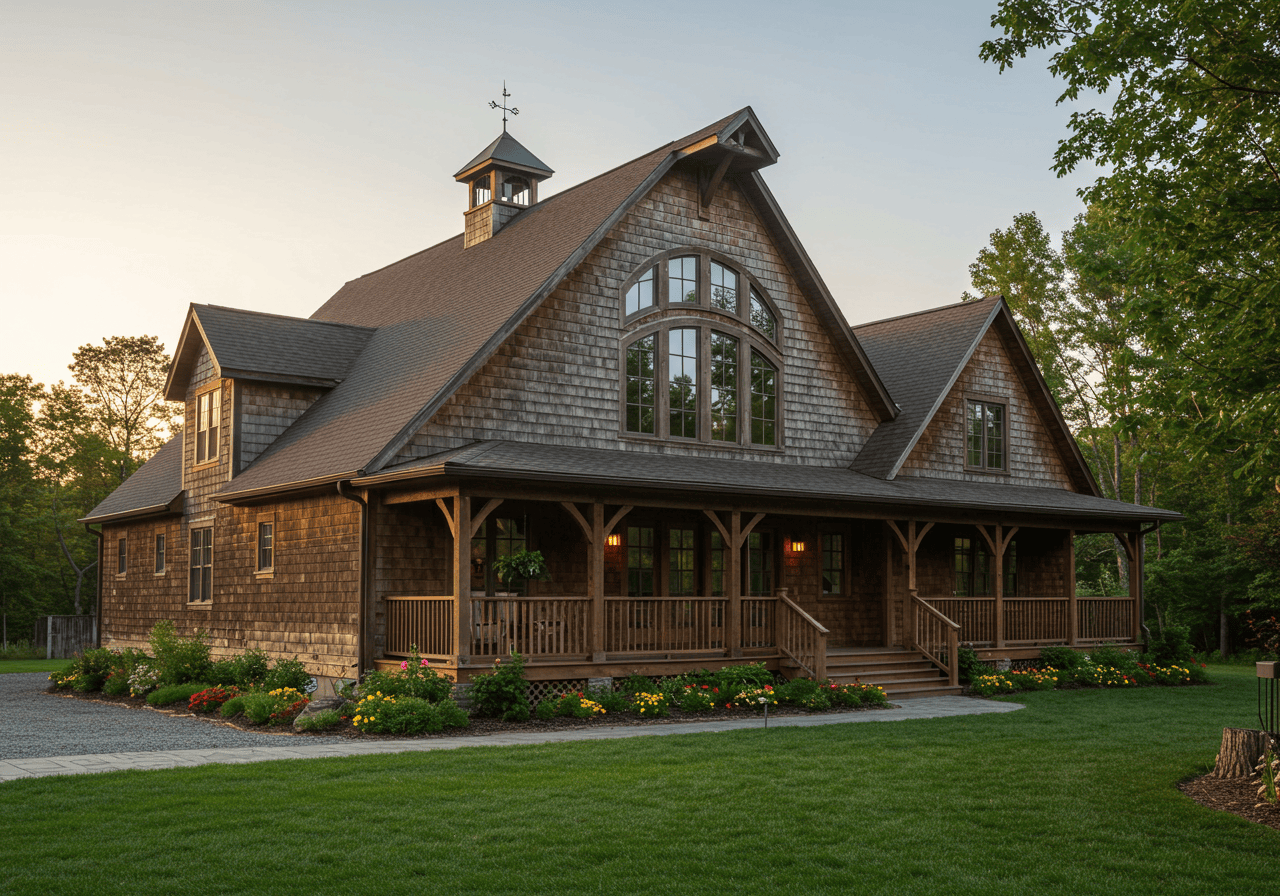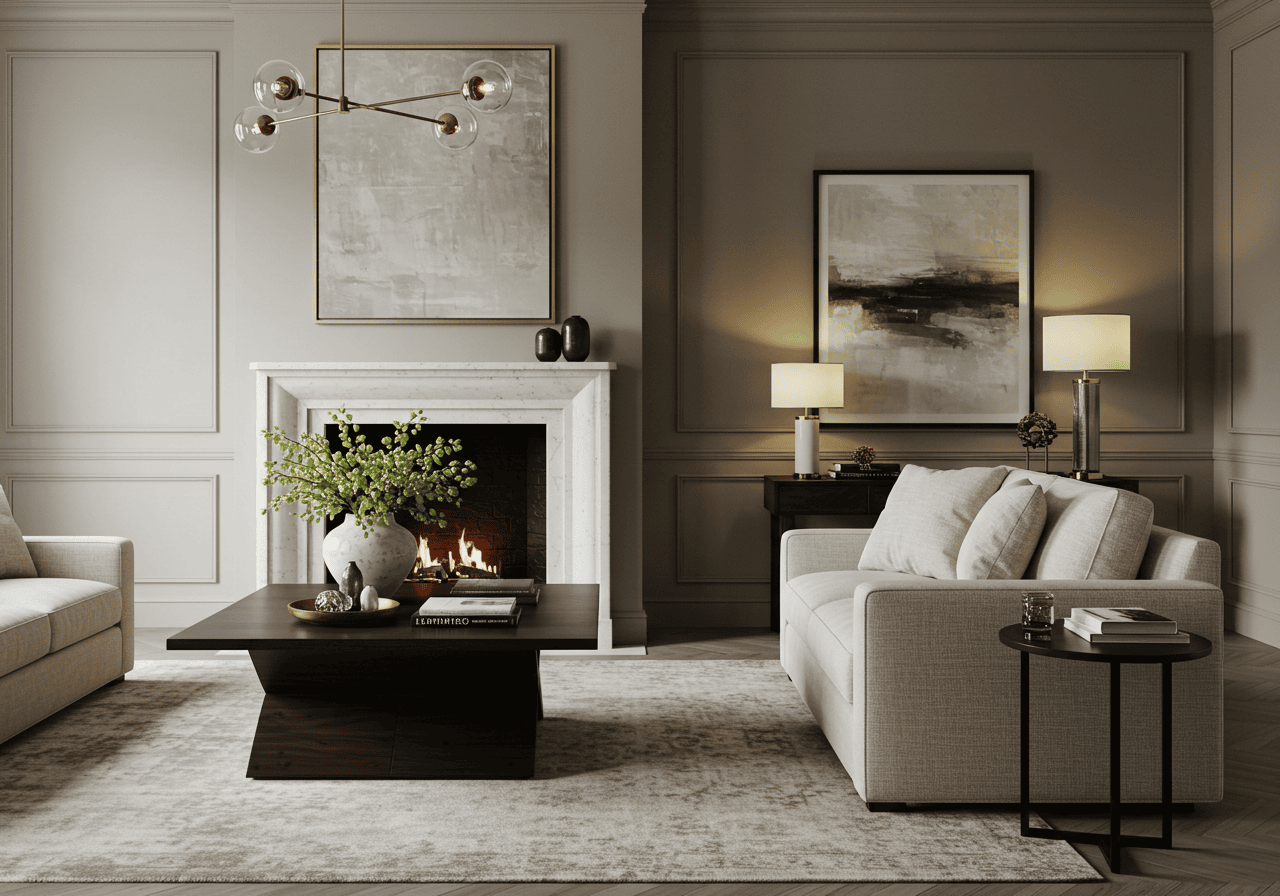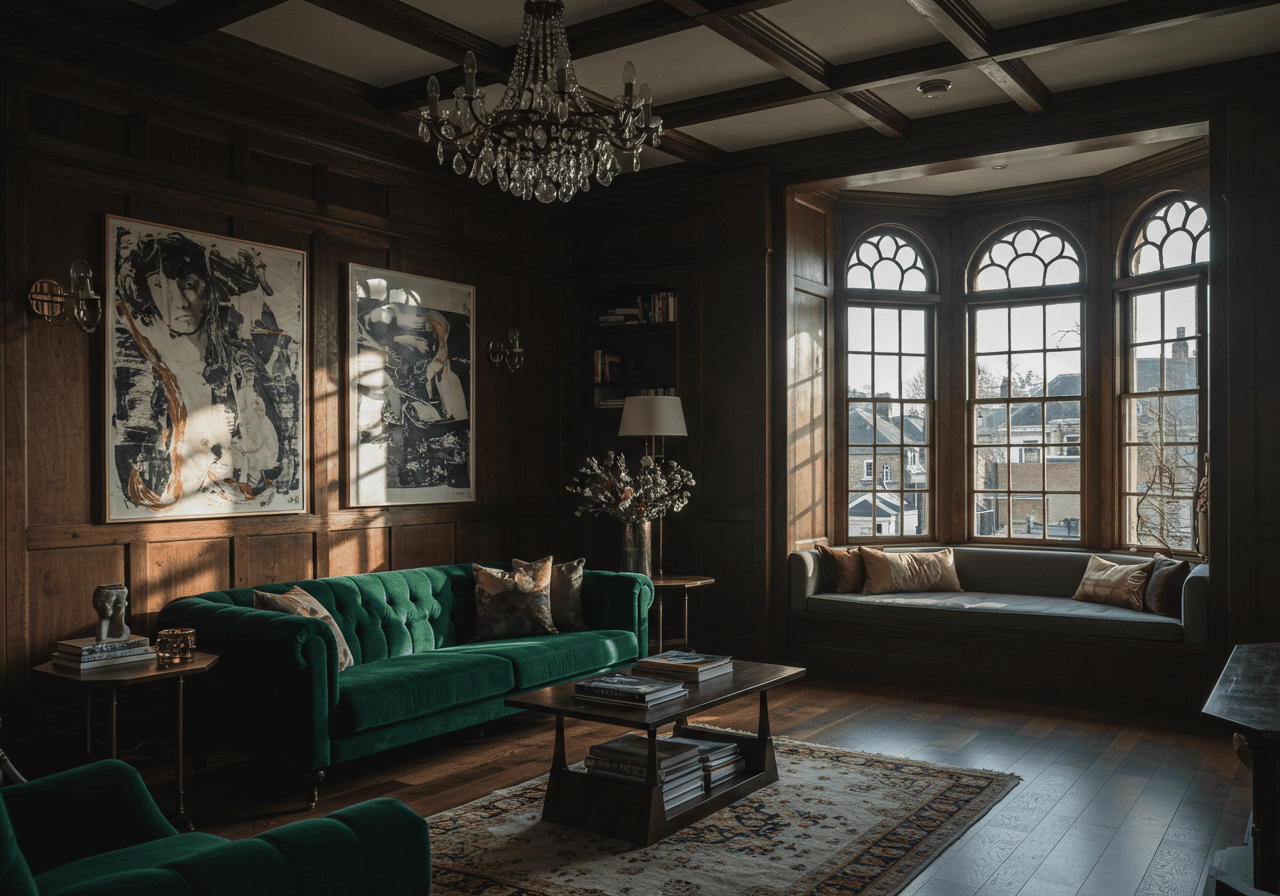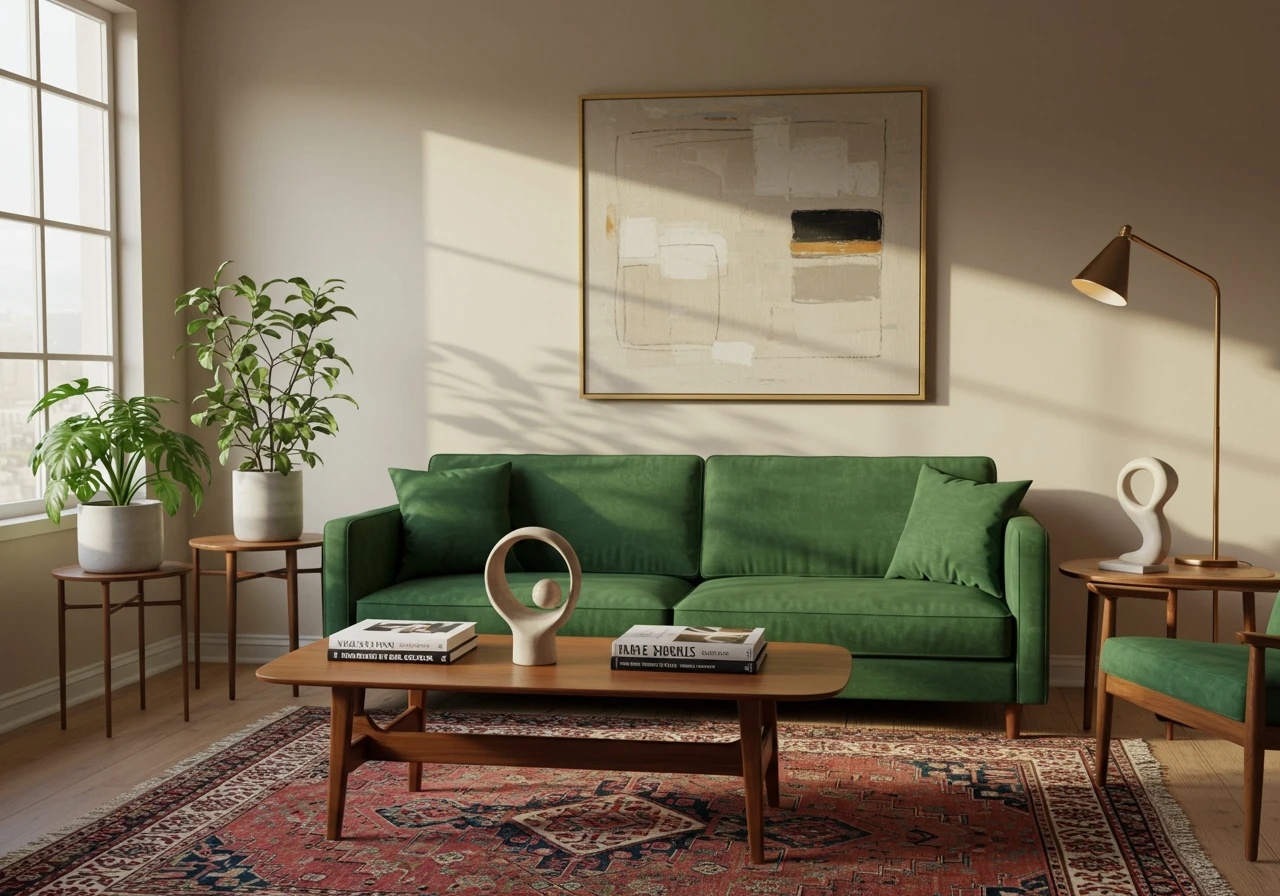Craving a home style with undeniable strength and confidence? Let’s talk Brutalist interior design. Born from mid-century architecture’s love for raw concrete (béton brut) and structural honesty, this isn’t about cold, imposing spaces.
Forget severity! Today’s Brutalism is surprisingly warm, incredibly sophisticated, and dramatically chic. It masterfully blends raw materials, bold textures, and sculptural forms to create interiors that feel both powerful and grounded. It’s a far cry from the softness of Shabby Chic, offering instead a confident embrace of stripped-back elegance.
Ready to harness this raw beauty? Dive into 21 inspiring ideas designed to transform your home with commanding style. Let’s explore!
1. Anchor Your Space with Raw Concrete
Let’s start with the cornerstone: raw concrete. This isn’t about perfectly polished surfaces; it’s about celebrating the material’s inherent texture, imperfections, and visual weight.
- Why it Works: Concrete provides an immediate sense of solidity and grounding. It’s the perfect neutral-yet-impactful backdrop for furniture and decor, allowing other elements to shine while still making a strong statement itself. Its textural variations catch light beautifully, adding depth and character.
- How to Do It:
- Feature Walls: Dedicate one wall in your living room, bedroom, or even dining area to exposed concrete or a high-quality concrete plaster finish. This creates a powerful focal point.
- Flooring: Polished or semi-polished concrete floors offer durability and a seamless, industrial-chic look. Warm them up with textured area rugs.
- Architectural Elements: Think fireplace surrounds, built-in shelving units, or even kitchen countertops crafted from concrete.
- Expert Tip: Worried about the commitment or complexity of real concrete? Achieve a similar effect with microcement overlays (applied over existing surfaces), concrete-look porcelain tiles, or even sophisticated lime-wash or Roman clay paint techniques that mimic the texture and depth.
2. Celebrate Sculptural Forms & Geometric Shapes
Brutalism isn’t just about materials; it’s profoundly about form. Think strong silhouettes, geometric precision, and furniture that feels almost architectural in its construction. Forget fussy details; embrace bold, substantial shapes.
- Why it Works: Sculptural pieces act like functional art within the Brutalist framework. Their defined lines and often chunky proportions stand out beautifully against raw textures like concrete or brick, creating visual interest and a sense of deliberate design. This focus on form echoes the architectural origins of the movement.
- How to Do It:
- Statement Furniture: Look for sofas with blocky arms, coffee tables with geometric bases (think stacked cubes or monolithic slabs), or side chairs with strong, angular frames.
- Lighting: Choose fixtures that are sculptural in their own right – perhaps a pendant light made of interlocking geometric shapes or a hefty table lamp with a solid, Brutalist-inspired base.
- Decor Objects: Even small accessories can contribute. Think concrete planters with sharp angles, metal sculptures with clean lines, or even stacked books arranged in a geometric fashion.
- Expert Tip: Don’t be afraid to mix different geometric shapes within the same space, but maintain a sense of balance. A curved armchair can soften a room dominated by rectilinear forms, preventing it from feeling too harsh.
3. Welcome Warmth with Natural, Unfinished Wood
Think Brutalism is all cold stone and metal? Think again! Raw, natural wood plays a crucial role in balancing the style’s inherent intensity, adding warmth, organic texture, and a connection to nature.
- Why it Works: The natural grain, knots, and imperfections of unfinished or minimally treated wood provide a beautiful counterpoint to the smoothness or roughness of concrete and metal. It introduces organic lines and earthy tones, preventing the space from feeling sterile and adding a layer of inviting comfort. This approach shares a certain honesty about materials found in Rustic Home Decor, but with a more modern, less “country” edge.
- How to Do It:
- Wall Paneling: Consider a feature wall clad in rough-sawn timber planks or reclaimed wood.
- Furniture: Opt for pieces like dining tables, benches, or shelving units made from solid, substantial wood with visible grain and a natural finish (avoid high gloss).
- Ceiling Beams: Exposed wooden ceiling beams add architectural interest and rustic warmth.
- Flooring: Wide-plank wooden floors with a matte or oiled finish can beautifully complement concrete walls.
- Expert Tip: Choose woods with prominent grain patterns like oak, walnut, or reclaimed timber. A live-edge wooden piece (like a shelf or console table) can introduce a beautiful, organic contrast to the geometry elsewhere.
4. Layer In Heavy, Tactile Textures
Beyond concrete and wood, Brutalism thrives on a rich tapestry of heavy, tactile textures. This adds depth, visual interest, and prevents the minimalist palette from falling flat.
- Why it Works: Texture engages the senses beyond just sight. Rough fabrics, patinated metals, and ribbed surfaces invite touch and add a layer of lived-in sophistication. They break up large monolithic surfaces and create cozy nooks within the broader architectural feel. While different in execution, the emphasis on touchable surfaces is something Brutalism shares with the cozy appeal of Rustic Farmhouse Decor.
- How to Do It:
- Textiles: Choose fabrics like bouclé, thick wool, coarse linen, leather, or even canvas for upholstery, throws, and cushions. Think weight and noticeable weave.
- Rugs: Opt for high-pile wool rugs, chunky jute or sisal rugs, or even layered hides to add softness underfoot and define zones.
- Wall Treatments: Beyond concrete, consider textured plaster, exposed brick (painted or natural), or fluted wood paneling.
- Metals: Incorporate metals with texture – brushed brass, blackened steel, cast iron, or hammered copper.
- Expert Tip: Layer different textures within the same color family to create subtle depth. For instance, combine a smooth leather sofa with rough linen cushions and a chunky knit throw, all in shades of grey or beige.
5. Embrace a Muted, Monochromatic Palette
While Brutalism is bold in form and texture, its color palette is typically restrained. Think muted, earthy, and often monochromatic schemes that let the materials and shapes take center stage.
- Why it Works: A limited palette creates a sense of cohesion and calm, allowing the architectural elements and textural details to shine without competing for attention. Shades of grey, beige, black, white, and deep earth tones (like ochre or terracotta) emphasize the natural origins of the materials used. This focus on a limited, impactful palette can be seen in other styles too, like the stark contrast favored in Black and White Aesthetic interiors.
- How to Do It:
- Base Colors: Use varying shades of grey (from pale concrete to deep charcoal), beige, taupe, or off-white for walls, floors, and large furniture pieces.
- Accent Colors: Introduce subtle accents through natural wood tones, touches of black for definition (metal frames, light fixtures), or a single, deep, earthy color like forest green, deep blue, or rust, used sparingly in textiles or decor.
- Material Tones: Let the inherent colors of your materials – the grey of concrete, the brown of wood, the black of steel – form the core of your palette.
- Expert Tip: To prevent a monochromatic scheme from feeling flat, ensure you have plenty of textural variation (as discussed above!). The interplay of light and shadow on different surfaces will create depth and interest even within a single color family.
6. Introduce Industrial Metal Accents
Alongside concrete and wood, industrial metals are key players in the Brutalist material palette. Think blackened steel, cast iron, brushed brass, or even corten (weathering) steel – materials that speak of strength, function, and often possess a beautiful patina.
- Why it Works: Metals provide a sleek or rugged contrast to the textures of concrete and wood. They add definition, reflect light subtly (or absorb it, in the case of blackened steel), and reinforce the industrial undertones inherent in Brutalism. Their durability and sense of permanence align perfectly with the style’s ethos.
- How to Do It:
- Furniture Frames: Look for chairs, tables, or shelving units with exposed metal legs or frameworks.
- Lighting Fixtures: Metal is a natural choice for Brutalist lighting – think raw steel pendants, cast iron sconces, or lamps with heavy metal bases.
- Hardware: Update cabinet pulls, door handles, and fixtures with substantial metal options.
- Structural Elements: Exposed ductwork or pipes (if authentic to the space) can be embraced rather than hidden.
- Decorative Objects: Metal bowls, trays, or sculptures add small but impactful metallic touches.
- Expert Tip: Don’t shy away from metals with a bit of age or patina. A slightly weathered or oxidized finish adds character and depth, preventing the metal elements from looking too new or slick against the rawer materials.
7. Make Room for Monumental Art
In a style characterized by strong forms and often vast wall spaces (like exposed concrete), large-scale, impactful art finds a perfect home. Think bold abstracts, geometric prints, or even striking black and white photography.
- Why it Works: Monumental art complements the scale and presence of Brutalist architecture and interiors. It prevents large, raw walls from feeling empty or unfinished, adding personality and a focal point without introducing clutter. The art should feel intentional and substantial, echoing the weight of the surrounding materials. This contrasts sharply with the gallery walls or numerous smaller pieces often found in Eclectic Home Decor.
- How to Do It:
- Go Big: Choose one or two significantly sized pieces rather than multiple small ones.
- Abstract & Geometric: Styles that emphasize form, texture, or bold color fields often work well.
- Textural Art: Consider pieces made from plaster, layered canvas, or even metal wall sculptures that add physical texture.
- Monochromatic: Black and white photography or art provides stark contrast and sophistication.
- Simple Framing: Use minimal frames (or no frames at all for canvas works) – simple black, white, or natural wood gallery frames are ideal.
- Expert Tip: Position large art strategically to balance architectural features. For instance, hang a tall vertical piece on a concrete column or a wide horizontal piece above a long, low sofa to complement their forms.
8. Keep Window Treatments Minimal (or Bare)
Brutalism often celebrates natural light and architectural lines. Heavy, fussy window treatments can detract from this. Opt for minimalist solutions or leave windows bare where privacy allows.
- Why it Works: Unadorned windows emphasize the connection between the interior and exterior, allow maximum natural light to flood the space (highlighting textures), and showcase the window frames themselves as architectural elements. It maintains the clean lines and uncluttered feel central to the Brutalist aesthetic.
- How to Do It:
- Bare Windows: If privacy isn’t a concern, leaving windows completely uncovered is the most authentic Brutalist approach.
- Simple Roller Shades: Choose unobtrusive roller shades in neutral colors (grey, white, black, beige) that practically disappear when rolled up.
- Plain Linen or Cotton Panels: If curtains are necessary, opt for simple, floor-length panels in solid, textural fabrics like linen or heavy cotton, hung on a discreet track or simple metal rod. Avoid patterns, valances, or elaborate tie-backs.
- Architectural Integration: Consider recessed blinds or shades that integrate seamlessly into the window frame or ceiling.
- Expert Tip: If using fabric panels, choose a color that closely matches the wall color for a seamless, unobtrusive look. The goal is function and light control without visual clutter.
9. Illuminate with Sculptural Statement Lighting
Forget hidden spotlights; in Brutalist design, lighting fixtures are often functional sculptures in their own right. Choose pieces that are bold, geometric, and make a deliberate statement.
- Why it Works: Statement lighting adds another layer of sculptural interest, reinforcing the focus on form. Fixtures crafted from materials like concrete, metal, or even heavy glass complement the core material palette. They draw the eye upwards and can define specific zones within an open-plan space. This appreciation for iconic lighting has parallels with Mid-Century Modern Decor, though Brutalist fixtures often lean towards more rugged or blocky forms.
- How to Do It:
- Geometric Pendants: Look for oversized pendants featuring spheres, cubes, clusters of geometric shapes, or raw metal shades.
- Architectural Floor Lamps: Choose lamps with strong lines, heavy bases (perhaps concrete or marble), and adjustable arms that feel almost industrial.
- Wall Sconces as Art: Select sconces that cast interesting light patterns or have a distinct sculptural form, perhaps in cast metal or textured ceramic.
- Track Lighting (Used Architecturally): Simple track lighting with robust, directional spotlights can highlight architectural features or artwork effectively.
- Expert Tip: Consider the interplay of light and shadow. Choose fixtures that not only illuminate but also cast interesting shadows on the textured walls, adding another layer of depth and drama to the space.
10. Master the Art of Negative Space
Brutalism isn’t about filling every corner; it’s about strategic emptiness, or negative space. Allowing room for elements to breathe emphasizes their form and the overall architectural quality of the interior.
- Why it Works: Negative space provides visual relief and prevents the strong materials and forms from feeling overwhelming. It highlights the shape and silhouette of individual furniture pieces and draws attention to the textures and architectural details. It’s a key element in creating a sense of calm sophistication amidst the boldness. This contrasts strongly with the ‘more is more’ philosophy of styles like Maximalism Home Decor.
- How to Do It:
- Resist Clutter: Be highly selective about furniture and decor. Each piece should serve a purpose or make a significant visual statement.
- Strategic Placement: Arrange furniture to create clear pathways and allow empty floor space to be appreciated. Don’t push everything against the walls.
- Focus on Form: Let the shape of a single striking chair or the texture of a bare concrete wall be the focus, rather than surrounding it with distractions.
- Edit Ruthlessly: Regularly assess your space and remove anything that doesn’t contribute positively to the overall composition.
- Expert Tip: Think of negative space as an active element in your design, not just leftover area. Use it deliberately to frame views, highlight specific objects, and create a sense of balance and tranquility.
11. Design with Monolithic Forms
Think beyond individual furniture pieces and embrace monolithic forms – large, solid structures that appear carved from a single block. This could be a kitchen island, a built-in bench, or even a commanding fireplace structure.
- Why it Works: Monolithic elements embody the weighty, sculptural essence of Brutalism. They create powerful focal points, define zones within open spaces, and convey an undeniable sense of permanence and strength, directly referencing the architectural scale of the movement’s origins.
- How to Do It:
- Kitchen Island: Design a kitchen island that looks like a solid block of concrete, stone, or dark wood, minimizing visible hardware or overhangs.
- Built-In Seating: Integrate bench seating into wall niches or along walls, constructed from concrete or wood to appear as part of the architecture.
- Fireplace Surrounds: Create a floor-to-ceiling fireplace surround using large slabs of stone or a seamless concrete finish, emphasizing its mass.
- Platform Beds: Opt for low, solid platform beds that feel anchored and substantial.
- Expert Tip: To prevent monolithic forms from feeling too heavy, ensure adequate surrounding space (negative space!) and balance them with lighter elements elsewhere in the room, such as slender lighting fixtures or open shelving.
12. Expose and Celebrate Structural Honesty
True to its architectural roots, Brutalism values honesty in materials and construction. Where possible, exposing structural elements like brick walls, concrete columns, steel beams, or even ductwork can add authentic character.
- Why it Works: Revealing the ‘bones’ of a building aligns perfectly with the Brutalist ethos of celebrating raw materials and functional forms. These elements add texture, industrial edge, and a sense of history or structural integrity to the space, preventing it from feeling overly polished or artificial.
- How to Do It:
- Exposed Brick: If you have existing brick walls, consider stripping them back. They can be left natural, sealed, or painted (often white or grey) to fit the palette while retaining texture.
- Concrete Columns/Beams: Don’t cover structural concrete elements; leave them exposed as features.
- Steel Beams: Painted or raw steel beams can add a strong industrial line, especially across ceilings.
- Visible Ductwork/Pipes: In loft spaces or homes with industrial bones, leaving ductwork or pipes exposed (perhaps painted matte black or grey) can enhance the aesthetic rather than detracting from it.
- Expert Tip: Balance is key. Not every structural element needs to be exposed. Choose the ones that make the most impact and ensure they are clean and intentionally presented, rather than just looking neglected. If exposing isn’t feasible, you can mimic the look with high-quality faux brick panels or concrete plaster finishes.
13. Choose Furniture with Weight and Presence
Brutalist-inspired furniture isn’t flimsy or delicate. It has visual weight, often blocky or geometric forms, and a sense of permanence. Look for pieces that feel substantial and grounded.
- Why it Works: Furniture with presence holds its own against strong architectural backdrops like concrete walls. It reinforces the style’s emphasis on form, solidity, and functionality. These pieces often become focal points, anchoring seating areas or dining spaces. While distinct, this focus on strong forms sometimes echoes the solidity seen in certain Art Deco Interior Design pieces, though Brutalism favors raw materials over Art Deco’s glamour.
- How to Do It:
- Solid Silhouettes: Look for sofas with low, deep seats and wide, blocky arms; coffee tables that resemble solid geometric blocks; dining tables with thick tops and substantial legs.
- Material Focus: Choose furniture made from solid wood, concrete, metal, or upholstered in heavy, textural fabrics like leather, bouclé, or thick linen.
- Vintage Finds: Hunt for authentic late mid-century or 1970s pieces that embody the Brutalist spirit – think designs by Paul Evans or furniture featuring chunky chrome or dark wood.
- Simplicity is Key: Avoid overly ornate details, complex patterns, or spindly legs. Focus on clean lines and powerful shapes.
- Expert Tip: Even if you can’t find explicitly Brutalist furniture, choose pieces with a strong minimalist or geometric aesthetic and substantial construction. A simple, well-made platform bed or a monolithic block-style coffee table can fit perfectly.
14. Apply Brutalist Principles to the Bathroom
The bathroom is a fantastic space to experiment with Brutalist design, transforming a purely functional room into a sanctuary of texture and form. Think raw materials, clean lines, and minimalist functionality.
- Why it Works: Materials like concrete, stone, and metal are naturally suited to the moisture-rich environment of a bathroom. The style’s emphasis on clean lines and minimal clutter creates a spa-like sense of calm and order. It’s a departure from typical tile-heavy bathrooms, offering a unique, sophisticated alternative. You might even find inspiration by contrasting these raw elements with the sleek lines sometimes seen in a Mid-Century Modern Bathroom, focusing here on texture over MCM’s color pops.
- How to Do It:
- Concrete Surfaces: Consider a cast concrete vanity top, microcement walls or floors, or even a concrete bathtub surround.
- Stone Elements: Natural stone sinks (like travertine or rough-hewn granite) or stone tiles with texture add an earthy, robust feel.
- Minimalist Fixtures: Choose simple, geometric taps and shower fittings in matte black, brushed nickel, or raw brass.
- Wood Accents: Incorporate a natural wood vanity unit (with a protective finish) or wooden bath mat for warmth.
- Frameless Glass: Use frameless glass shower screens to maintain clean lines and an open feel.
- Simple Lighting: Opt for architectural sconces or recessed lighting rather than decorative fixtures.
- Expert Tip: Ensure adequate ventilation, as natural materials like concrete and wood need proper care in humid environments. Sealing surfaces appropriately is crucial for longevity and maintenance.
15. Introduce Rough-Hewn Stone Elements
While concrete is king, rough-hewn natural stone like granite, slate, travertine, or even rugged fieldstone brings another layer of raw, earthy texture and gravitas to Brutalist interiors.
- Why it Works: Natural stone offers unique textures, color variations, and imperfections that concrete might not possess. It connects the interior to the natural world in a powerful, unrefined way, reinforcing the themes of honesty and permanence while adding visual depth and tactile interest.
- How to Do It:
- Feature Walls: Use stacked stone or large, rough-cut stone slabs for an accent wall, perhaps behind a bed or framing a fireplace.
- Flooring: Consider textured slate or travertine tiles for floors, especially in entryways or bathrooms, embracing their natural variations.
- Countertops: Opt for honed or leathered finishes on granite or quartzite countertops instead of highly polished surfaces.
- Solid Stone Sinks: A basin carved from a single block of stone makes a dramatic statement in a bathroom or powder room.
- Expert Tip: Choose stone with visible texture and minimal processing. The less polished and uniform it looks, the better it typically aligns with the Brutalist aesthetic. Ensure it’s properly sealed for its intended use (e.g., countertops, bathroom floors).
16. Prioritize Functionality and Purpose
Beneath the bold aesthetics, Brutalism has roots firmly planted in functionality. Every element should feel purposeful, contributing to the usability and flow of the space, not just its appearance.
- Why it Works: This emphasis on function leads to uncluttered, practical spaces where form naturally follows function. It avoids superfluous decoration, reinforcing the clean lines and honest expression of materials. Furniture is chosen for comfort and utility as much as for style, creating interiors that are genuinely livable.
- How to Do It:
- Layout Matters: Plan your room layout for optimal flow and ease of movement. Ensure seating areas are conducive to conversation and workspaces are efficient.
- Multi-Functional Pieces: Consider furniture that serves multiple purposes, like an ottoman with storage or a console table that doubles as a desk.
- Integrated Storage: Build in storage solutions (like recessed shelving or handleless cabinets) that blend seamlessly with the architecture, minimizing visual clutter.
- Task Lighting: Ensure adequate task lighting where needed (reading nooks, kitchen counters, desks) using functional yet stylish fixtures.
- Assess Necessity: Before adding any item, ask yourself: “What purpose does this serve?” If it’s purely decorative, ensure it makes a strong enough statement to justify its presence.
- Expert Tip: Functionality doesn’t mean sacrificing style. Look for pieces where the functional design is the aesthetic appeal – think cantilevered shelves, well-designed ergonomic chairs, or cleverly integrated technology.
17. Master the Nuances of Grey
While the Brutalist palette is muted, mastering the spectrum of grey is crucial. From the palest concrete dust to the deepest charcoal, layering different shades and textures of grey adds sophistication and depth.
- Why it Works: Grey is the quintessential Brutalist neutral. Using multiple shades prevents the monochromatic scheme from feeling flat or one-dimensional. Variations in tone highlight different forms and textures, creating subtle contrasts and enhancing the interplay of light and shadow.
- How to Do It:
- Wall Finishes: Use different grey tones for different walls or employ techniques like lime wash or concrete plaster to create tonal variation on a single surface.
- Textiles: Layer throws, cushions, and rugs in various grey shades – think light grey linen, medium grey wool, dark charcoal bouclé.
- Furniture: Combine pieces in different greys – perhaps a medium grey sofa with darker grey armchairs or a light grey concrete coffee table.
- Material Greys: Incorporate the natural greys of concrete, stone, and weathered metal.
- Expert Tip: Introduce warmth within the grey palette by choosing greys with subtle undertones (e.g., greenish-grey, brownish-grey or ‘greige’) or by pairing them strategically with natural wood tones.
18. Play with Diffused Light Through Glass Blocks
A subtle nod to mid-century architectural elements, glass blocks can introduce texture, pattern, and diffused light into a Brutalist space without compromising privacy or the overall robust feel.
- Why it Works: Glass blocks offer a unique textural quality and geometric pattern that complements Brutalist forms. They allow light to pass through in a softened, diffused way, illuminating spaces while maintaining separation or privacy. They provide a translucent contrast to the opaque solidity of concrete and stone.
- How to Do It:
- Interior Walls/Partitions: Use glass blocks to create non-load-bearing partition walls, perhaps separating a home office or defining an entryway.
- Shower Enclosures: Incorporate a section of glass blocks into a shower wall for privacy and light diffusion.
- Window Features: Replace a standard window in a bathroom or basement with glass blocks for light without sacrificing privacy.
- Backsplashes: A glass block backsplash (ensure proper sealing) can add unexpected texture in a kitchen.
- Expert Tip: Choose glass blocks with simple patterns or a frosted finish rather than overly decorative or colored options. Integrate them thoughtfully as architectural features rather than random accents.
19. Ground the Space with Leather Furniture
Leather, particularly in darker or natural tones and with a matte or slightly worn finish, is a fantastic upholstery choice for Brutalist interiors. It adds warmth, texture, durability, and a touch of rugged sophistication.
- Why it Works: Leather offers a rich textural contrast to concrete and metal while complementing the natural warmth of wood. Its durability aligns with the Brutalist emphasis on lasting materials. As it ages, quality leather develops a beautiful patina, further enhancing the aesthetic of imperfection and character.
- How to Do It:
- Statement Pieces: Consider a leather sofa or armchair as an anchor piece in the living room.
- Dining Chairs: Leather-upholstered dining chairs (perhaps with metal frames) add comfort and style.
- Color Palette: Opt for classic leather colors like black, charcoal grey, deep brown, tan, or cognac. Avoid bright or artificial colors.
- Texture Focus: Choose leathers with a visible grain or a slightly distressed finish over highly polished or patent leathers.
- Accents: If a full leather sofa feels like too much, introduce leather through ottomans, benches, or cushions.
- Expert Tip: Pair leather furniture with softer textures, like a wool rug or linen cushions, to balance its visual weight and add layers of comfort.
20. Master the Play of Scale
Brutalism often involves playing with scale – juxtaposing large, monolithic architectural elements with smaller, carefully chosen details, or placing oversized furniture in a way that feels intentional rather than overwhelming.
- Why it Works: This dynamic interplay of scale creates visual interest and drama. Large elements establish the dominant feel, while smaller details provide focal points and humanize the space. Getting the scale right prevents the interior from feeling either too empty or too cluttered.
- How to Do It:
- Anchor with Large Forms: Start with the large statements – the concrete wall, the oversized sofa, the monumental artwork.
- Introduce Contrasting Scales: Add smaller elements like side tables, lamps, or decorative objects, ensuring they relate to the larger pieces but offer a different scale.
- Consider Height: Utilize vertical space with tall plants, floor lamps, or artwork in rooms with high ceilings. In lower-ceilinged rooms, emphasize horizontal lines with low-slung furniture.
- Grouping: Group smaller objects together (e.g., three ceramic vases of varying heights) to give them more visual weight against larger elements.
- Expert Tip: Pay attention to the “visual weight” of objects, not just their physical size. A dark, solid object will feel heavier and larger in scale than a light-colored object of the same size with open framework. Use this to balance your composition.
21. Dare to Be Bold and Commit
Finally, embracing Brutalist interior design requires a degree of confidence and commitment. It’s not a timid style; it makes a statement. Don’t dilute its power by trying to mix it too heavily with conflicting aesthetics.
- Why it Works: The strength of Brutalism lies in its unapologetic celebration of raw materials, strong forms, and functional honesty. Committing to the core principles ensures a cohesive and impactful result. Half-measures can lead to a space that feels confused rather than confidently styled.
- How to Do It:
- Trust Your Vision: If you’re drawn to Brutalism, embrace its defining characteristics fully.
- Focus on the Core: Prioritize the key elements: raw materials (concrete, wood, metal), sculptural forms, texture, a muted palette, and functionality.
- Edit ruthlessly: Remove items that don’t align with the Brutalist ethos, even if you like them individually. Cohesion is key.
- Be Patient: Achieving an authentic Brutalist feel can take time, especially if sourcing specific materials or vintage pieces. Don’t rush to fill the space.
- Expert Tip: While commitment is crucial, remember that your home should still feel comfortable and personal. Inject your personality through carefully selected art, meaningful objects, or textiles that soften the edges without undermining the core style. It’s about finding your balance within the bold framework of Brutalism.
There you have it – 21 ways to bring the compelling power and sophisticated rawness of Brutalist design into your own home. It’s a style that rewards boldness and an appreciation for materials in their most honest form. Ready to make a statement?



